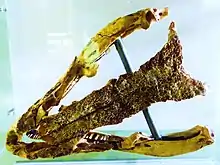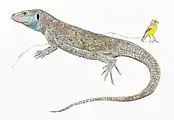| Gallotia goliath Temporal range: Late Pleistocene-Holocene | |
|---|---|
 | |
| Skull in Museo de la Naturaleza y el Hombre of Santa Cruz de Tenerife. | |
| Scientific classification | |
| Domain: | Eukaryota |
| Kingdom: | Animalia |
| Phylum: | Chordata |
| Class: | Reptilia |
| Order: | Squamata |
| Family: | Lacertidae |
| Genus: | Gallotia |
| Species: | †G. goliath |
| Binomial name | |
| †Gallotia goliath Mertens, 1942 | |
| Synonyms | |
| |
Gallotia goliath (the Tenerife giant lizard or goliath Tenerife lizard[2]) is an extinct giant lizard species from the island of Tenerife of the Canary Islands, Spain. This reptile lived before the arrival of humans and is believed to have grown to at least 0.9 metres (3.0 ft) long.[3] It was described by the German herpetologist Robert Mertens. Fossils of this lizard have been found in volcanic caves, where they often appear with those of other animals, like the Tenerife giant rat.
Classification
Prehistoric Gallotia remains have been assigned to the taxa G. maxima and G. goliath, the former supposedly occurring only on Tenerife, the latter on several islands. It was eventually determined, however, that G. maxima is a junior synonym of G. goliath, and that the latter was close to the El Hierro giant lizard (Gallotia simonyi); supposed goliath specimens from El Hierro, La Gomera, and La Palma (from the Cuevas de los Murciélagos) are probably just extremely large individuals of, respectively, the El Hierro, La Gomera (Gallotia bravoana) and La Palma (Gallotia auaritae) giant lizards.[4] Based on DNA sequence analysis of mummified remains, G. goliath is a valid species that probably was restricted to Tenerife, and apparently was closer to the Tenerife speckled lizard (Gallotia intermedia) than to the El Hierro giant lizard.[5]
Characteristics
G. goliath was the largest reptile in the Canary Islands, reaching a length of 120 to 125 cm (3.94 to 4.10 ft) but based on the finding of a 13.5 cm (5.3 in) skull in 1952, there could have been even larger specimens. These giant lizards inhabited the coastal lowlands of the island.[6]
Extinction
It inhabited Tenerife from the late Pleistocene through the Holocene until the fifteenth century of our era. Bone remains of this species have been found in different archaeological sites with marks that show that they were consumed by the aborigines of the island (Guanches). There is written documentation about its existence in the fifteenth century, so its extinction must have occurred in the years after the conquest of the Canaries by the Castilians.
Gallery
 Mummified specimen in Museo de la Naturaleza y el Hombre.
Mummified specimen in Museo de la Naturaleza y el Hombre. Model in Museo de la Naturaleza y el Hombre.
Model in Museo de la Naturaleza y el Hombre. Life restoration, based on known remains and extant Gallotia lizards. A canary (Serinus canaria) is shown for size reference
Life restoration, based on known remains and extant Gallotia lizards. A canary (Serinus canaria) is shown for size reference
See also
Notes
- ↑ Bravo, Telésforo. Lacerta maxima n. sp. de la fauna continental extinguida del Pleistoceno de las Canarias. Instituto "Lucas Mallada" de Investigaciones Geológicas, 1953.
- ↑ "The Recently Extinct Plants and Animals Database Extinct Reptiles: Gallotia goliath". Archived from the original on 2017-03-17. Retrieved 2017-03-16.
- ↑ Barahona et al., 2000, p. 381
- ↑ Barahona et al., 2000
- ↑ Maca-Meyer et al., 2003
- ↑ Martin, A. (2006). "3. Aportaciones de D. Telesforo Bravo al conocimiento de la fauna de vertebrados terrestres de las islas Canarias" (PDF). From the book: En Afonso-Carrillo, J. (Ed.), Actas de la Semana homenaje a Telesforo Bravo. Instituto de Estudios Hispánicos de Canarias. pp. 71–92. ISBN 84-611-0482-X.
References
- Barahona, F.; Evans, S. E.; Mateo, J. A.; García-Márquez, M.; López-Jurado, L. F. (March 2000). "Endemism, gigantism and extinction in island lizards: the genus Gallotia on the Canary Islands". Journal of Zoology. 250 (3): 373–388. doi:10.1111/j.1469-7998.2000.tb00781.x. hdl:10553/19918.
- Maca-Meyer, N.; Carranza, S.; Rando, J. C.; Arnold, E. N.; Cabrera, V. M. (1 December 2003). "Status and relationships of the extinct giant Canary Island lizard Gallotia goliath (Reptilia: Lacertidae), assessed using ancient mtDNA from its mummified remains". Biological Journal of the Linnean Society. 80 (4): 659–670. doi:10.1111/j.1095-8312.2003.00265.x.